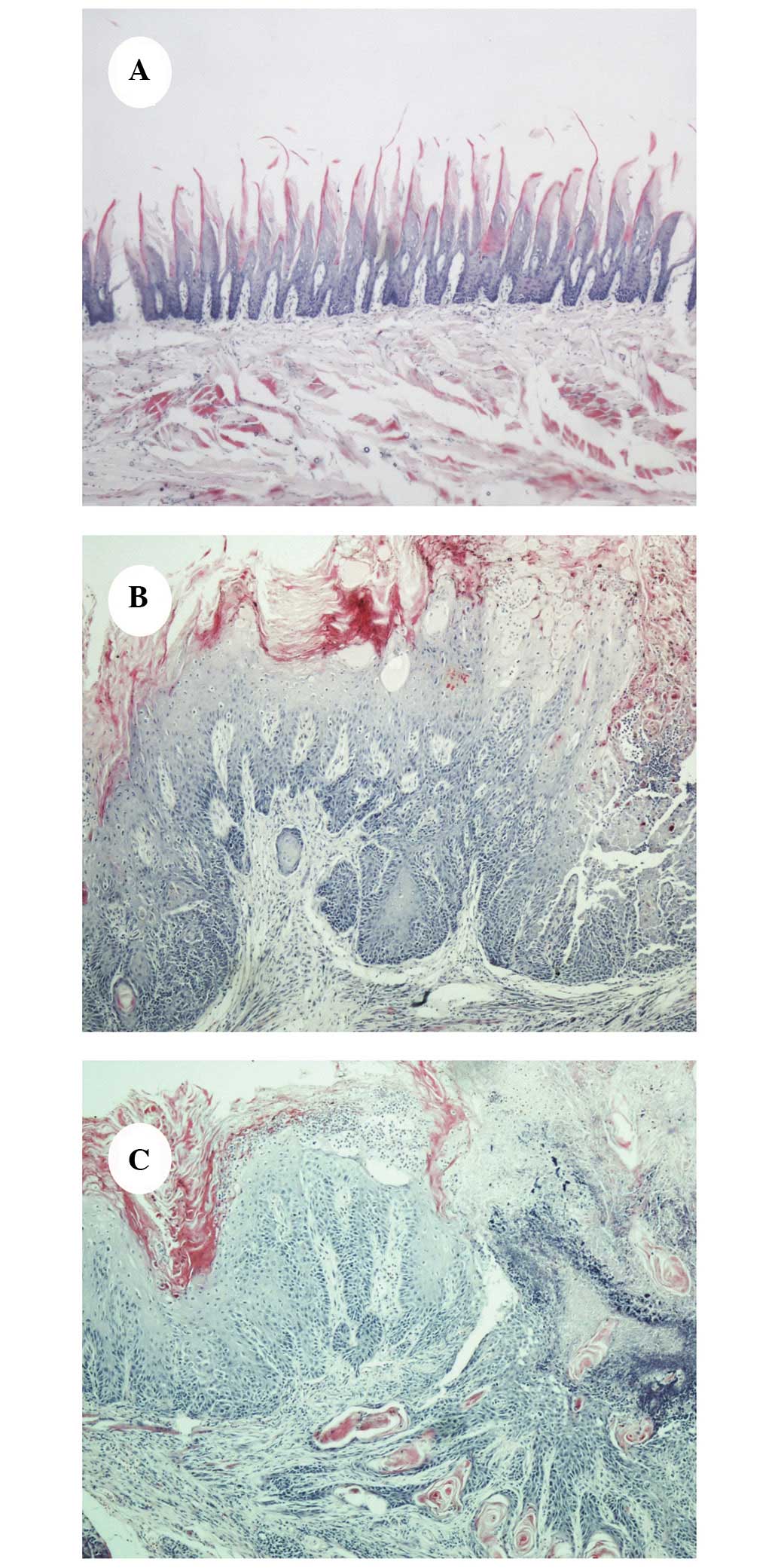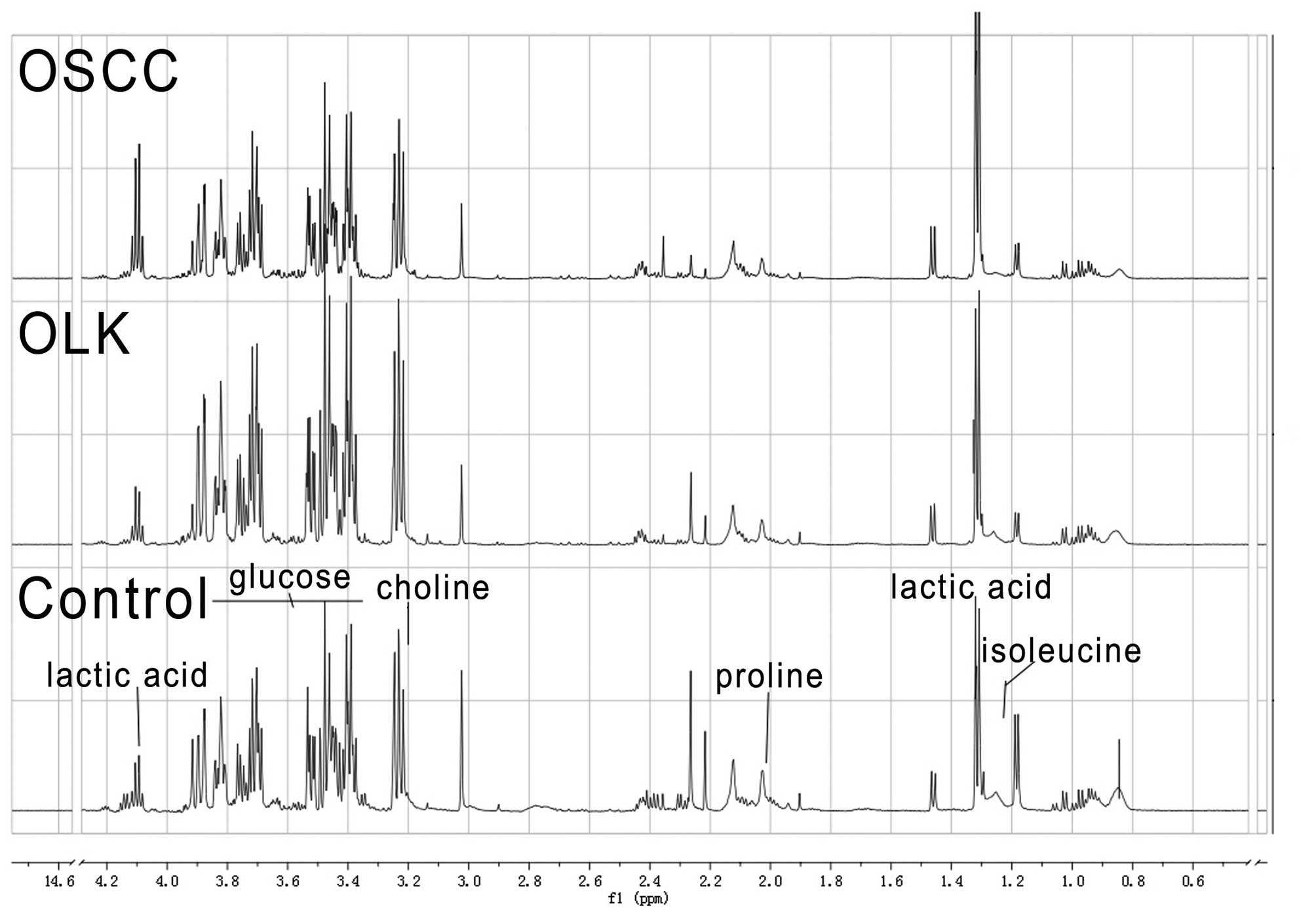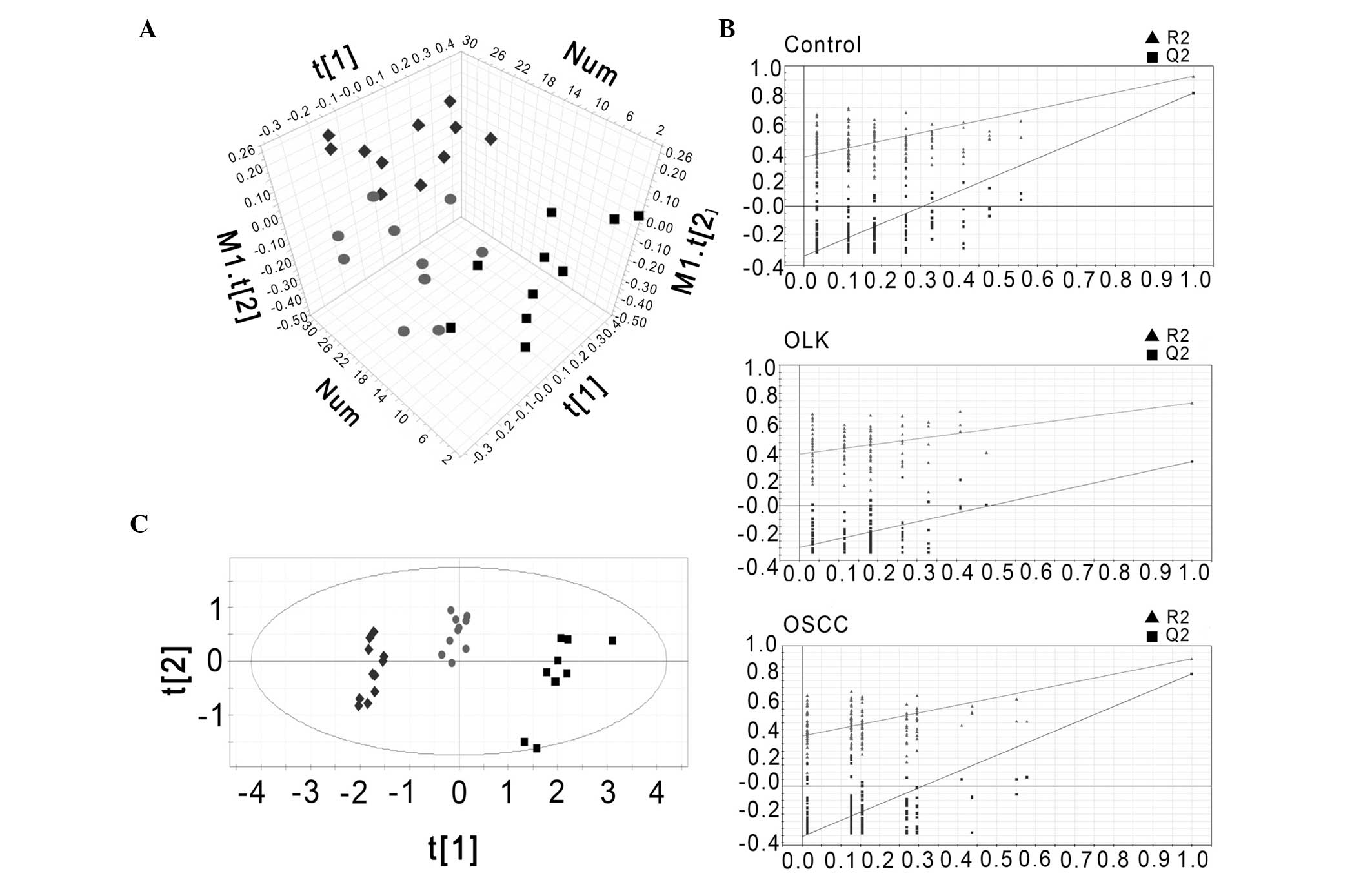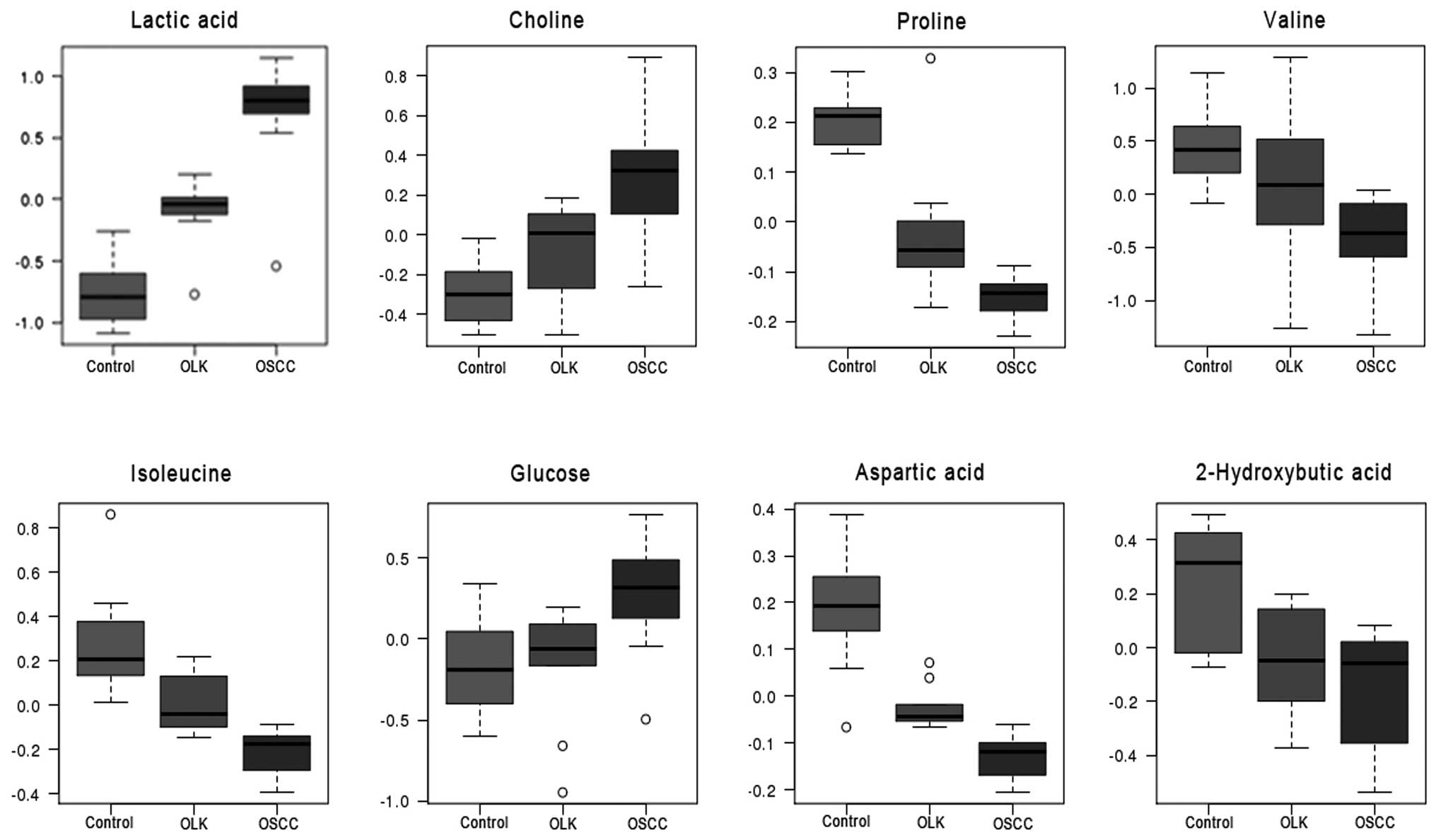|
1
|
Nair DR, Pruthy R, Pawar U and Chaturvedi
P: Oral cancer: Premalignant conditions and screening - an update.
J Cancer Res Ther. 8(Suppl 1): S57–S66. 2012.
|
|
2
|
Mehrotra R and Gupta DK: Exciting new
advances in oral cancer diagnosis: avenues to early detection. Head
Neck Oncol. 3:332011. View Article : Google Scholar : PubMed/NCBI
|
|
3
|
Yan SK, Wei BJ, Lin ZY, et al: A
metabonomic approach to the diagnosis of oral squamous cell
carcinoma, oral lichen planus and oral leukoplakia. Oral Oncol.
44:477–483. 2008. View Article : Google Scholar
|
|
4
|
Tiziani S, Lopes V and Günther UL: Early
stage diagnosis of oral cancer using 1H NMR-based
metabolomics. Neoplasia. 11:269–276. 2009.
|
|
5
|
Zhou J, Xu B, Huang J, et al:
1H NMR-based metabonomic and pattern recognition
analysis for detection of oral squamous cell carcinoma. Clin Chim
Acta. 401:8–13. 2009. View Article : Google Scholar
|
|
6
|
Wei J, Xie G, Zhou Z, et al: Salivary
metabolite signatures of oral cancer and leukoplakia. Int J Cancer.
129:2207–2217. 2011. View Article : Google Scholar
|
|
7
|
Xie GX, Chen TL, Qiu YP, et al: Urine
metabolite profiling offers potential early diagnosis of oral
cancer. Metabolomics. 8:220–231. 2012. View Article : Google Scholar
|
|
8
|
Wei J, Xie G, Ge S, et al: Metabolic
transformation of DMBA-induced carcinogenesis and inhibitory effect
of salvianolic acid b and breviscapine treatment. J Proteome Res.
11:1302–1316. 2012. View Article : Google Scholar
|
|
9
|
Kanojia D and Vaidya MM:
4-nitroquinoline-1-oxide induced experimental oral carcinogenesis.
Oral Oncol. 42:655–667. 2006. View Article : Google Scholar : PubMed/NCBI
|
|
10
|
Nauta JM, Roodenburg JL, Nikkels PG,
Witjes MJ and Vermey A: Epithelial dysplasia and squamous cell
carcinoma of the Wistar rat palatal mucosa: 4NQO model. Head Neck.
18:441–449. 1996. View Article : Google Scholar : PubMed/NCBI
|
|
11
|
Tang XH, Knudsen B, Bemis D, Tickoo S and
Gudas LJ: Oral cavity and esophageal carcinogenesis modeled in
carcinogen-treated mice. Clin Cancer Res. 10:301–313. 2004.
View Article : Google Scholar : PubMed/NCBI
|
|
12
|
Qing C, Zhang LF, Wei H, Gu WW and Wang J:
Laboratory animal science. Beijing: People’s medical publishing
house; 2010
|
|
13
|
Barnes L, Eveson JW, Reichart P and
Sidransky D: World Health Organization Classification of Tumours.
Pathology and Genetics of Head and Neck Tumours. IARC Press; Lyon:
2005
|
|
14
|
Warnakulasuriya S, Reibel J, Bouquot J and
Dabelsteen E: Oral epithelial dysplasia classification systems:
predictive value, utility, weaknesses and scope for improvement. J
Oral Pathol Med. 37:127–133. 2008. View Article : Google Scholar : PubMed/NCBI
|
|
15
|
Lucas LH, Larive CK, Wilkinson PS and Huhn
S: Progress toward automated metabolic profiling of human serum:
comparison of CPMG and gradient-filtered NMR analytical methods. J
Pharm Biomed Anal. 39:156–163. 2005. View Article : Google Scholar : PubMed/NCBI
|
|
16
|
Vilela M, Borges CC, Vinga S, et al:
Automated smoother for the numerical decoupling of dynamics models.
BMC bioinformatics. 8:305–312. 2007. View Article : Google Scholar : PubMed/NCBI
|
|
17
|
Zhong F, Liu X, Zhou Q, et al:
1H NMR spectroscopy analysis of metabolites in the
kidneys provides new insight into pathophysiological mechanisms:
applications for treatment with Cordyceps sinensis. Nephrol Dial
Transplant. 27:556–565. 2012. View Article : Google Scholar
|
|
18
|
Weljie AM, Bondareva A, Zang P and Jirik
FR: 1H NMR metabolomics identification of markers of
hypoxia-induced metabolic shifts in a breast cancer model system. J
Biomol NMR. 49:185–193. 2011. View Article : Google Scholar : PubMed/NCBI
|
|
19
|
Xia J and Wishart DS: Web-based inference
of biological patterns, functions and pathways from metabolomic
data using MetaboAnalyst. Nat Protoc. 6:743–760. 2011. View Article : Google Scholar : PubMed/NCBI
|
|
20
|
Lippman SM, Sudbø J and Hong WK: Oral
cancer prevention and the evolution of molecular-targeted drug
development. J Clin Oncol. 23:346–356. 2005. View Article : Google Scholar : PubMed/NCBI
|
|
21
|
Ristow M: Oxidative metabolism in cancer
growth. Curr Opin Clin Nutr Metab Care. 9:339–345. 2006. View Article : Google Scholar : PubMed/NCBI
|
|
22
|
Brizel DM, Schroeder T, Scher RL, et al:
Elevated tumor lactate concentrations predict for an increased risk
of metastases in head-and-neck cancer. Int J Radiat Oncol Biol
Phys. 51:349–353. 2001. View Article : Google Scholar : PubMed/NCBI
|
|
23
|
Gatenby RA and Gawlinski ET: A
reaction-diffusion model of cancer invasion. Cancer Res.
56:5745–5753. 1996.PubMed/NCBI
|
|
24
|
Wopereis S, Rubingh CM, van Erk MJ, et al:
Metabolic profiling of the response to an oral glucose tolerance
test detects subtle metabolic changes. PLoS One. 4:e45252009.
View Article : Google Scholar : PubMed/NCBI
|
|
25
|
Landaas S and Pettersen JE: Clinical
conditions associated with urinary excretion of 2-hydroxybutyric
acid. Scand J Clin Lab Invest. 35:259–266. 1975. View Article : Google Scholar : PubMed/NCBI
|
|
26
|
Wagle SR, Morris HP and Weber G:
Comparative biochemistry of hepatomas. V Studies on amino acid
incorporation in liver tumors of different growth rates. Cancer
Res. 23:1003–1007. 1963.PubMed/NCBI
|
|
27
|
Glunde K, Jacobs MA and Bhujwalla ZM:
Choline metabolism in cancer: implications for diagnosis and
therapy. Expert Rev Mol Diagn. 6:821–829. 2006. View Article : Google Scholar : PubMed/NCBI
|
|
28
|
Möller-Hartmann W, Herminghaus S, Krings
T, et al: Clinical application of proton magnetic resonance
spectroscopy in the diagnosis of intracranial mass lesions.
Neuroradiology. 44:371–381. 2002. View Article : Google Scholar : PubMed/NCBI
|
|
29
|
van Dorsten FA, van der Graaf M,
Engelbrecht MR, et al: Combined quantitative dynamic
contrast-enhanced MR imaging and 1H MR spectroscopic
imaging of human prostate cancer. J Magn Reson Imaging. 20:279–287.
2004. View Article : Google Scholar : PubMed/NCBI
|
|
30
|
Jacobs MA, Barker PB, Bottomley PA,
Bhujwalla Z and Bluemke DA: Proton magnetic resonance
spectroscoptic imaging of human breast cancer: a preliminary study.
J Magn Reson Imaging. 19:68–75. 2004. View Article : Google Scholar
|













